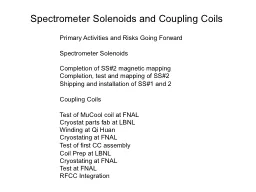PPT-Can we detect signs of training in solenoids?
Author : jade | Published Date : 2023-11-12
If so what can we learn from them Part one Solenoid fabrication By Charlie Sanabria and Sofía Jiménez Viñolo First Prototype Development of an experiment
Presentation Embed Code
Download Presentation
Download Presentation The PPT/PDF document "Can we detect signs of training in solen..." is the property of its rightful owner. Permission is granted to download and print the materials on this website for personal, non-commercial use only, and to display it on your personal computer provided you do not modify the materials and that you retain all copyright notices contained in the materials. By downloading content from our website, you accept the terms of this agreement.
Can we detect signs of training in solenoids?: Transcript
Download Rules Of Document
"Can we detect signs of training in solenoids?"The content belongs to its owner. You may download and print it for personal use, without modification, and keep all copyright notices. By downloading, you agree to these terms.
Related Documents














